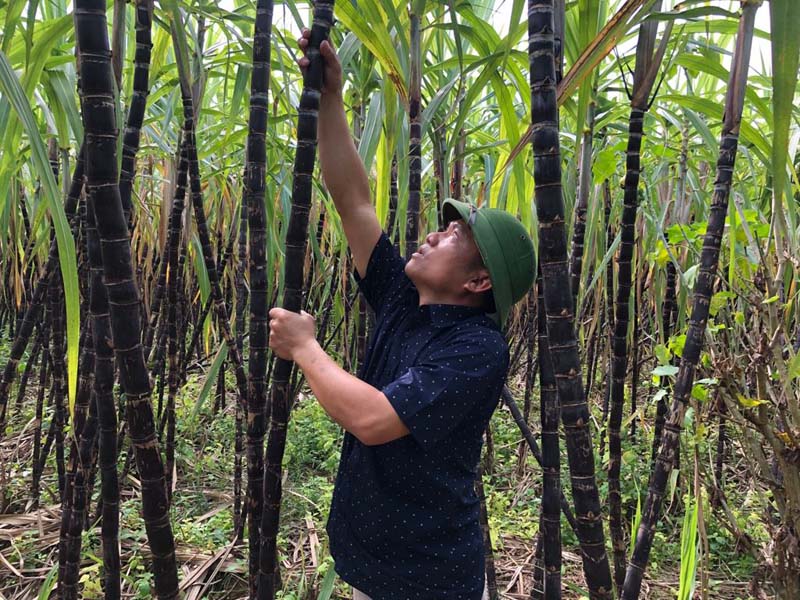
(HBO) – Since 2016, tissue culture sugarcane has been put into production in Hoa Binh province to gradually replace the local purple sugarcane variety which has been degraded through many years of cultivation. This model is part of a project replacing the purple sugarcane variety with tissue culture sugarcane implemented by the local centre for application of scientific-technological advances.
 Farmers
in Treo Ngoai hamlet, Nam Phong commune (Cao Phong district), grow tissue
culture sugarcane, which has proved superior economic efficiency.
Farmers
in Treo Ngoai hamlet, Nam Phong commune (Cao Phong district), grow tissue
culture sugarcane, which has proved superior economic efficiency.
By now, harvest has completed on all the areas
under tissue culture sugarcane, with each stalk sold for 5,500 to 6,000 VND,
bringing a profit of about 50 percent for growers.
Hoa Binh localities have been expanding the growing area and
directing farmers to proactively seek markets.
Vu Quang Hung, head of the agriculture and rural
development office in Tan Lac district said the sale of purple sugarcane is
facing difficulties, with prices lower than that of tissue culture plants by
about 2,000 VND each stalk.
After three years of implementing the cultivation
of tissue culture sugarcane in Cao Phong, Tan Lac and Yen Thuy district, Hoa
Binh has expanded the growing area to 145 hectares.
Specifically, Cao Phong district now has 35.67
hectares under tissue culture sugarcane, Tan Lac 73 hectares, and Yen Thuy 33.2
hectares.
Though still modest, the cultivation of tissue
culture sugarcane has helped remove difficulties in production and sales of
purple sugarcane in recent years. The province currently has 3,000 ha under
purple sugarcane.
The project of replacing purple sugarcane with
tissue culture sugarcane was carried out by the local centre to conserve the
gene of purple sugarcane using Invitro technology. The cultivation of tissue
culture sugarcane was first implemented in Tan Lac and Cao Phong districts.
Tissue culture sugarcane has received good feedback on the market on its
quality. This is an important prerequisite for the province to expand the
cultivation of this plant./.
After more than four years of implementing a project launched by the Hoa Binh Party Committee’s Standing Board on developing agriculture and promoting product consumption linked with building new-style rural areas for the 2021-2025 period, the province’s industry and trade sector has made significant strides, greatly contributing to local socio-economic development.
Luong Son district has identified 2025 as the year for the accelerated breakthrough to successfully implement the socio-economic development plan for the 5-year period from 2021 to 2025. The district has been focusing on executing the plans and trying to achieve a GRDP growth rate of approximately 15%.
Since the beginning of this year, under the direction of the Department of Agriculture and Environment, the Sub-Department of Agricultural, Forestry, and Fishery Product Quality Management has strengthened the integration of the professional activities to promote and guide the organizations and individuals in the production and trading of agricultural, forestry, and fishery products to comply with the legal regulations regarding the use of chemicals, pesticides and veterinary medicines in crop cultivation, livestock farming and aquaculture. They also provide guidance to processing and manufacturing establishments on keeping the records to trace the product origins and using food additives from the approved list according to the regulations.
Hoa Binh province saw a significant rise in state budget revenue in the first two months of 2025, heard a meeting chaired by Vice Chairman of the provincial People’s Committee Quach Tat Liem.
Ha Thi Ha Chi, a 26-year-old graduate in law, has taken an unconventional path by returning to her hometown in Mai Chau district to establish the Tong Dau Cooperative, creating stable jobs for local women and bringing Thai ethnic brocade weaving to the global market.
As the Lunar New Year 2025 approached, pork prices surged, creating a profitable season for farmers in Tan Vinh commune, Luong Son district. Taking advantage of the rising demand, Can Minh Son, a farmer from Coi hamlet, sold over 30 pigs at 69,000 VND/kg, each weighing more than 100 kg. After deducting expenses, his family earned a profit of over 50 million VND.



 Farmers
in Treo Ngoai hamlet, Nam Phong commune (Cao Phong district), grow tissue
culture sugarcane, which has proved superior economic efficiency.
Farmers
in Treo Ngoai hamlet, Nam Phong commune (Cao Phong district), grow tissue
culture sugarcane, which has proved superior economic efficiency.